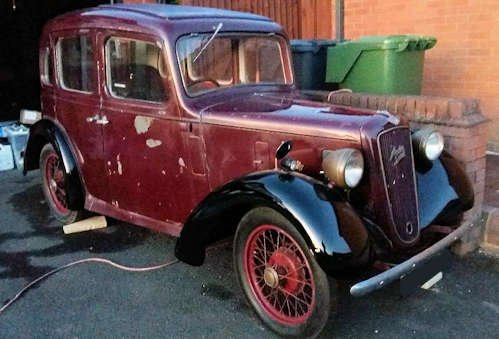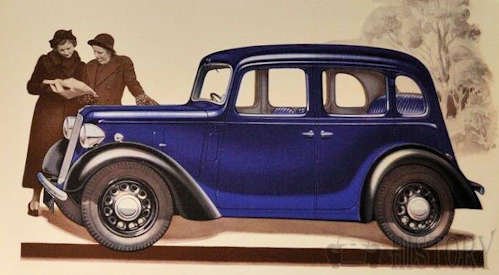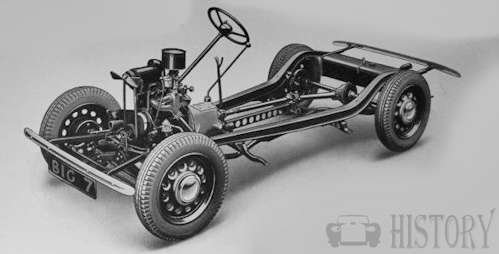Austin Big 7 car history
 |
|
|
Manufacturer: |
Austin |
|
Production period: |
1937 to 1939 |
|
Class : |
Motor car |
|
Body versions : |
Saloon ,2 or 4 door |
|
Engines: |
Petrol 0.9 liter |
The Austin Big 7 was a compact car of the Austin range of the late 1930s, built by the Austin Motor Co in 1937 as a supplement to the Austin 7 between the Seven Ruby range. By 1939, after three years the production was stopped. Successor was the Austin 8 .It was not a great success, although in total 23,514 were produced.This model filled the gap in the Austin range of the late 1930s, between the Seven Ruby, which continued in parallel with the 747 cc engine and was a refined version Of the immortal Seven, and the contemporary 10/4.
The Big 7 had by now a dated chassis came just before Austin committed to the semi-unitary construction and the chassis layout of the Ruby was used, The Big 7 price at around £160 was not highly regarded in its day with little space even with suicide doors the 'boot' had space for only the spare wheel,the luggage had to be carried in its open boot with the lid open.The Austin "Big Seven" Although its name implies it to be a larger edition of the ' 'Seven," the design is completely new. The engine, developing 25 b.h,p. at 4.000 r.p.m., is a 4-cylinder, water-cooled unit. A new type of flexible clutch takes up the transmission. The gearbox has 4 speeds, and the final drive is by open propeller shaft with needle-bearing universal joints and torque tube to the spiral-bevel drive in the three-quarter floating rear axle. Girling-type brakes are fitted, and 'shock absorbers -are large area friction type. The patented triangular chassis frame is similar to that used on the Austin "Seven," with a transverse semi-elliptic spring at the front and quarter-elliptic springs at the rear.

The Big 7 was about 12 inches longer than the Austin 7 The overall length is 11 ft. 2 in., wheelbase 7 ft. 3b in., track at rear 3 ft. 9 in. ,There were four seats, , with a steel body in two and four-door saloon body and had a larger four-cylinder engine .The 900 cc engine offered little power advantage over the 747 cc Seven unit. From 900 cc 25 bhp (18 kW ). So the car top speed of aound 90 km / h.
Engine: 4 cylinders, bore 56.77 mm. (2.235 in.). stroke 88.9 mm. (3.5 in.), cubic capacity 900 c.c. (54.97 cu. in.). Tax {6. It is mounted on live rubber at three points, two forward and one rear. The 4 cylinders and crankcase are cast in one unit with detachable head and sump. The side valves are slightly inclined and are on the nearside of the engine, while the pistons are of anodised low-expansion aluminium alloy. The counter-balanced crankshaft is carried in three bi-metal bearings, which are lubricated by a gear-type pump. 14 mm. plugs are fitted. Carburation : A Zenith down-draught carburettor with an intake silencer and air-cleaner is fitted.A 6-gallon capacity petrol tank is mounted at the rear of the chassis, the fuel being fed to by means of a mechanical pump. An electric gauge mounted on the instrument panel records the fuel contents. An integral casting incorporating inlet and exhaust manifolds with adequate hotspot is provided. Carburettor control is made possible by a foot-operated accelerator and hand-operated strangler.
Cooling System : Thermo-syphon cooling is assisted by fan, and water passages surround all cylinders.
Lubrication : The engine is lubricated by means of a pump driven Off the camshaft. Oil returning to the sump is filtered through a gauze before entering into the circulation system. The main, big-end and camshaft bearings receive their lubricant under pressure through drilled oil passages. An Enot's grease-gun is provided for chassis lubrication at twelve accessible nipples.
Ignition : Ignition is by coil and battery with automatic advance and retard mechanism incorporated in the distributor.
Gearbox : The 4-speed gearbox, which forms a unit with the engine, has synchromesh engagement for second, third and top, ensuring smooth,positive and noiseless gear-changing. All gears are of specially treated steel so that they withstand constant hard use. The gear ratios are : 22.394, 13.52, 8.522 and 5.125 to l, with 28.79 to 1 reverse gear.
Transmission : A new type of flexible clutch, in which a single spring plate carrying the two friction rings transmits the drive from the engine through the gearbox is employed. A smooth take-up is the result, and pedal operation is light.
Final Drive : An open propeller shaft with needle-bearing universal joints and a torque-tube-enclosed bevel pinion shaft (which is mounted on rubber to the frame cross member) transmits the drive from the gearbox through the three-quarter floating rear axle, spiral-bevel driven, to the
road wheels.

Technical
-
Austin Big 7 Technical details and specifications (1937-1939)
DIMENSIONS AND WEIGHT:
wheelbase, 755 in (192 cm)
Track: front, 43.2 in (110 cm); rear, 45 in (114 cm).ENGINE:
four cylinders in line side valve
Max power: 25 bhp at 2400 rpm.
BORE/STROKE -.56.77x88.9mm
CAPACITY -900 c.c.
FIRING ORDER -1-3-4-2
OIL PRESSURE -25 lb./sq. inTRANSMISSION DRIVE LINE:
four-speed manual gearbox
CLUTCH -Single Dry Plate
Type -Borg & BeckSUSPENSION:
non-independent; beam front axle, live rear axle; semi-elliptic Springs.BRAKES:
Drum
make:Girling
.
CARBURETTOR:
Make: Zenith
Choke :23
Main :90
Compensating :50
Slow Running :60© Motor car History
Service
-
Austin Big 7 Maintenance and Service Guide (1937-1939)
TAPPET CLEARANCES
Inlet :.............0.004" (Hot)
Exhaust :...........0.004" (Hot)VALVE TIMING
Mark location:............On flywheel
Inlet opens :. ...........T.D.C.
BREAKER GAP :............ 0.012"
PLUG GAP :............... 0.018"-0.020"
Ignition timing location..On flywheel
Ignition timing :.........T.D.C.TOE-IN :............ 1/16"
CAMBER :............ 1°
CASTER ANGLE :. .... 5°
KING PIN ANGLE :.... 6 1/4°© Motor car History
